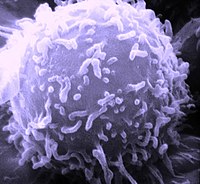
Photo from wikipedia
Severe cases of COVID‐19 present hyperinflammatory condition that can be fatal. Little is known about the role of regulatory responses in SARS‐CoV‐2 infection. In this study, we evaluated the phenotype… Click to show full abstract
Severe cases of COVID‐19 present hyperinflammatory condition that can be fatal. Little is known about the role of regulatory responses in SARS‐CoV‐2 infection. In this study, we evaluated the phenotype of regulatory T cells in the blood (peripheral blood mononuclear cell) and the lungs (broncho‐alveolar) of adult patients with severe COVID‐19 under invasive mechanical ventilation. Our results show important dynamic variation on Treg cells phenotype during COVID‐19 with changes in number and functional parameters from the day of intubation (Day 1 of intensive care unit admission) to Day 7. We observed that compared with surviving patients, non‐survivors presented lower numbers of Treg cells in the blood. In addition, lung Tregs of non‐survivors also displayed higher PD1 and lower FOXP3 expressions suggesting dysfunctional phenotype. Further signs of Treg dysregulation were observed in non‐survivors such as limited production of IL‐10 in the lungs and higher production of IL‐17A in the blood and in the lungs, which were associated with increased PD1 expression. These findings were also associated with lower pulmonary levels of Treg‐stimulating factors like TNF and IL‐2. Tregs in the blood and lungs are profoundly dysfunctional in non‐surviving COVID‐19 patients.
Journal Title: Immunology
Year Published: 2022
Link to full text (if available)
Share on Social Media: Sign Up to like & get
recommendations!